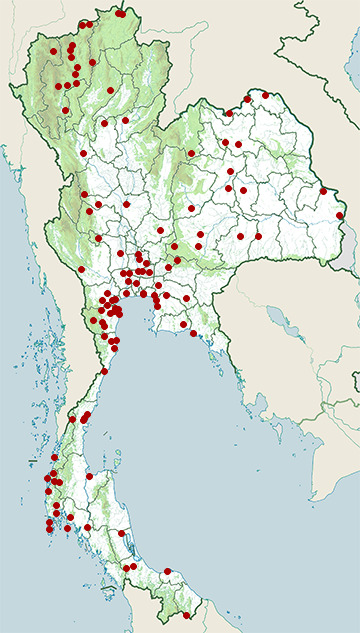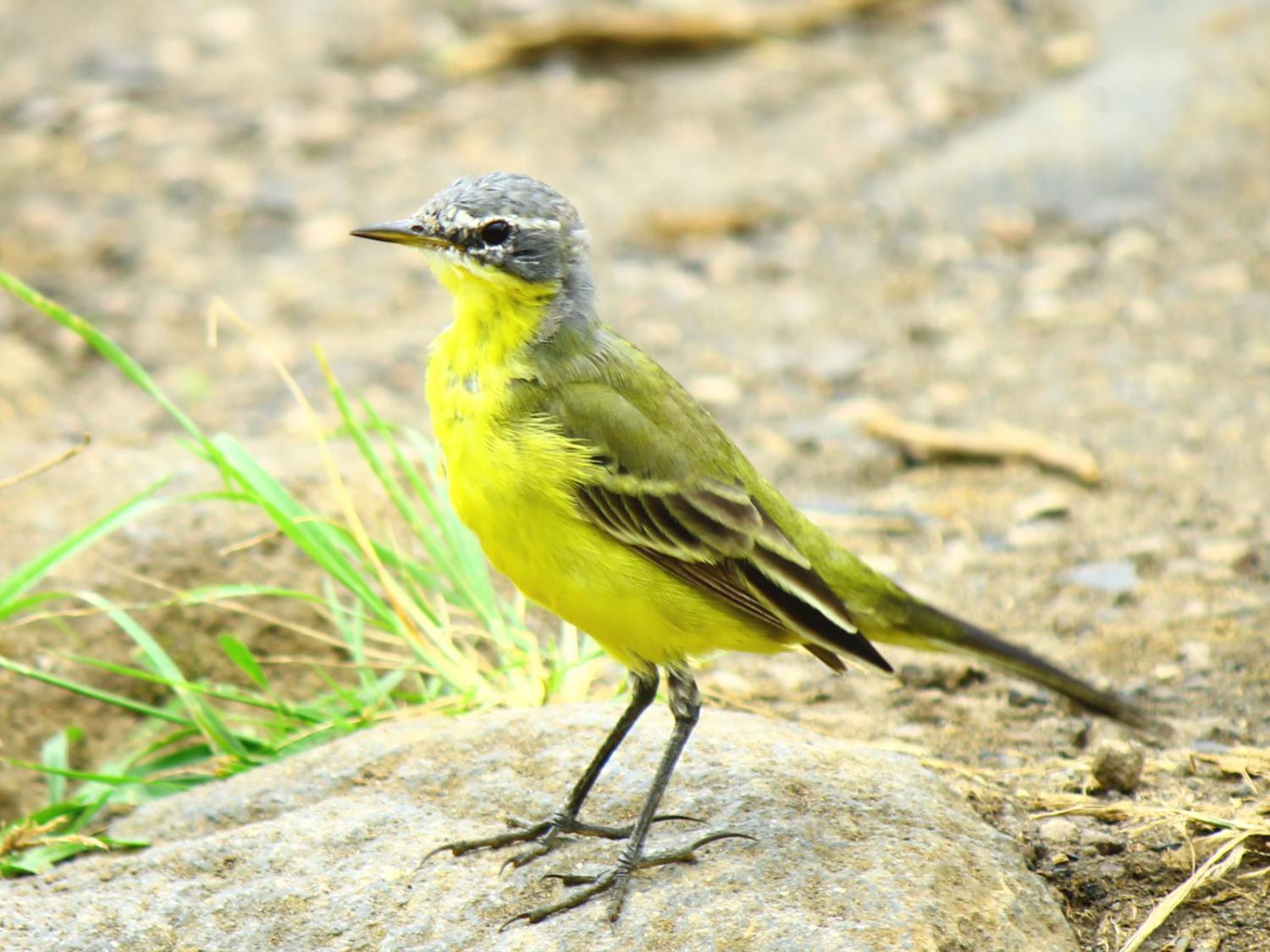Species of Thailand
Eastern yellow wagtail
Motacilla tschutschensis
Johann Friedrich Gmelin, 1789
In Thai: นกเด้าลมเหลือง
The eastern yellow wagtail (Motacilla tschutschensis) is a small passerine in the wagtail family Motacillidae, which also includes the pipits and longclaws. It was often classified as a subspecies of the Western yellow wagtail.
This species breeds in the East Palearctic and has a foothold in North America in Alaska. Populations migrate to south Asia and Australia.
Vagrant individuals occur around the winter quarters at migration time. For example, on Palau in Micronesia migrant flocks of this species – apparently of the Bering Sea yellow wagtail, and including many adult males – are regularly seen, while further north on the Marianas, only the occasional stray individual – usually females or immatures as it seems – is encountered.
It is a slender 15–16 cm long bird, with the characteristic long, constantly wagging tail of its genus. The breeding adult male is basically olive above and yellow below. In other plumages, the yellow may be diluted by white. The heads of breeding males come in a variety of colours and patterns depending on subspecies.
The call is a characteristic high-pitched jeet.
This insectivorous bird inhabits open country near water, such as wet meadows. It nests in tussocks, laying 4–8 speckled eggs.
The Acanthocephalan parasite Apororhynchus paulonucleatus was discovered in the colon and cloaca of the Eastern yellow wagtail.
Systematics
This species' systematics and phylogeny is extremely confusing. Literally dozens of subspecies have been described at one time or another, and 5 are currently considered valid depending on which author reviews them. In addition, the citrine wagtail (M. citreola) forms a cryptic species complex with this bird; both taxa as conventionally delimited are paraphyletic in respect to each other. In addition, some taxonomic authorities continue to keep the eastern and western yellow wagtails together as yellow wagtail, (M. flava).
Current subspecies:
- M. t. angarensis (Sushkin, 1925) – South Siberian yellow wagtail. Males like M. flava plexa, but supercilium more pronounced. Breeding: From S Siberia S through W Transbaikalia to N Mongolia. Winter: SE Asia.
- M. t. leucocephala (Przevalski, 1887) – White-headed yellow wagtail. Male like M. f. flava, but grey of head very pale, almost white. Female like flava females, but head somewhat darker. Breeding: NW Mongolia and adjacent PRC and Russia. Winter: probably India.
- M. t. taivana (Swinhoe, 1863) – Green-crowned yellow wagtail or Kuril yellow wagtail. Like M. f. flavissima but daker above, ears much darker, almost black. Sexes similar. Breeding: between ranges of plexa and tschutschensis S via Sakhalin to N Hokkaidō. Winter: Myanmar to Taiwan, S to Wallacea.
- M. t. macronyx (Stresemann, 1920) – Southeast Siberian yellow wagtail. Males like M. f. thunbergi but brighter and more strongly marked overall. Female like in thunbergi but no supercilium. Breeding: SE Transbaikalia E to coast, S to Manchuria. Winter: NW of South China Sea.
- M. t. simillima Hartert, 1905 – Bering Sea yellow wagtail or short-tailed grey-headed wagtail. Both sexes similar to corresponding M. f. flava, but supercilium usually less pronounced. Breeding: Kamchatka and Bering Sea islands, possibly to Aleuts. Winter: SE Asia S to N Australia.
This article uses material from Wikipedia released under the Creative Commons Attribution-Share-Alike Licence 3.0. Eventual photos shown in this page may or may not be from Wikipedia, please see the license details for photos in photo by-lines.
Category / Seasonal Status
BCST Category: Recorded in an apparently wild state within the last 50 years
BCST Seasonal status: Non-breeding visitor
Scientific classification
- Kingdom
- Animalia
- Phylum
- Chordata
- Class
- Aves
- Order
- Passeriformes
- Family
- Motacillidae
- Genus
- Motacilla
- Species
- Motacilla tschutschensis
Common names
- Thai: นกเด้าลมเหลือง
Conservation status

Least Concern (IUCN3.1)
Photos
Please help us review the bird photos if wrong ones are used. We can be reached via our contact us page.
Range Map

- Amphawa District, Samut Songkhram
- Ao Phang-Nga National Park
- Ban Laem District, Phetchaburi
- Ban Lat District, Phetchaburi
- Ban Phai District, Khon Kaen
- Bang Len District, Nakhon Pathom
- Bang Pahan District, Phra Nakhon Si Ayutthaya
- Bang Pakong District, Chachoengsao
- Bang Phra Non-Hunting Area
- Bang Pu Recreation Centre
- Bangkok Province
- Borabue District, Maha Sarakham
- Bueng Boraped Non-Hunting Area
- Chatturat District, Chaiyaphum
- Chiang Dao District, Chiang Mai
- Chiang Dao Wildlife Sanctuary
- Chiang Saen District, Chiang Rai
- Chum Ta Bong District, Nakhon Sawan
- Dan Chang District, Suphan Buri
- Doi Inthanon National Park
- Doi Lo District, Chiang Mai
- Doi Pha Hom Pok National Park
- Doi Tao District, Chiang Mai
- Hala-Bala Wildlife Sanctuary
- Hat Wanakon National Park
- Hat Yai District, Songkhla
- Hua Hin District, Prachuap Khiri Khan
- Huai Chorakhe Mak Reservoir Non-Hunting Area
- Huai Kha Khaeng Wildlife Sanctuary
- Kaeng Krachan District, Phetchaburi
- Kaeng Krachan National Park
- Khao Dinsor (Chumphon Raptor Center)
- Khao Phra - Bang Khram Wildlife Sanctuary
- Khao Sam Roi Yot National Park
- Khao Sok National Park
- Khao Yai National Park
- Khao Yoi District, Phetchaburi
- Khemarat District, Ubon Ratchathani
- Khlong Luang District, Pathum Thani
- Khun Chae National Park
- Khung Kraben Non-Hunting Area
- Khura Buri District, Phang Nga
- Klaeng District, Rayong
- Ko Phra Thong
- Kromluang Chumphon Wildlife Sanctuary
- Kumphawapi District, Udon Thani
- Kut Thing Non-Hunting Area
- Laem Pak Bia
- Laem Son National Park
- Mae Ai District, Chiang Mai
- Mae Mo District, Lampang
- Mae Taeng District, Chiang Mai
- Mae Wong National Park
- Mueang Chachoengsao District, Chachoengsao
- Mueang Chiang Mai District, Chiang Mai
- Mueang Chonburi District, Chonburi
- Mueang Chumphon District, Chumphon
- Mueang Khon Kaen District, Khon Kaen
- Mueang Krabi District, Krabi
- Mueang Lamphun District, Lamphun
- Mueang Nakhon Ratchasima District, Nakhon Ratchasima
- Mueang Nong Khai District, Nong Khai
- Mueang Pattani District, Pattani
- Mueang Phang Nga District, Phang Nga
- Mueang Phetchaburi District, Phetchaburi
- Mueang Phuket District, Phuket
- Mueang Ratchaburi District, Ratchaburi
- Mueang Samut Sakhon District, Samut Sakhon
- Mueang Samut Songkhram District, Samut Songkhram
- Mueang Suphanburi District, Suphan Buri
- Mueang Surat Thani District, Surat Thani
- Mueang Surin District, Surin
- Mueang Tak District, Tak
- Mueang Uttaradit District, Uttaradit
- Nong Bong Khai Non-Hunting Area
- Nong Ya Plong District, Phetchaburi
- Nong Yai Area Development Project Under Royal Init
- Pa Sak Chonlasit Dam Non-Hunting Area
- Pai District, Mae Hong Son
- Pak Chong District, Nakhon Ratchasima
- Pak Phli District, Nakhon Nayok
- Pak Thale
- Pak Tho District, Ratchaburi
- Pak Thong Chai District, Nakhon Ratchasima
- Pha Taem National Park
- Phanat Nikhom District, Chonburi
- Phi Phi Islands
- Phra Nakhon Si Ayutthaya District, Phra Nakhon Si Ayutthaya
- Phu Foi Lom National Park
- Phu Kradueng District, Loei
- Phutthamonthon District, Nakhon Pathom
- Pran Buri District, Prachuap Khiri Khan
- Pran Buri Forest Park
- Rattanawapi District, Nong Khai
- Sai Noi District, Nonthaburi
- Sai Yok District, Kanchanaburi
- Samut Prakan Province
- San Sai District, Chiang Mai
- Si Satchanalai District, Sukhothai
- Sri Phang-nga National Park
- Takua Pa District, Phang Nga
- Tha Takiap District, Chachoengsao
- Tha Yang District, Phetchaburi
- Thalang District, Phuket
- Thale Noi Non-Hunting Area
- Thanyaburi District, Pathum Thani
- Ton Nga-Chang Wildlife Sanctuary
- Wang Noi District, Phra Nakhon Si Ayutthaya
- Wat Phai Lom & Wat Ampu Wararam Non-Hunting Area
